

Bloom's Taxonomy. Bloom's wheel, according to the Bloom's verbs and matching assessment types.
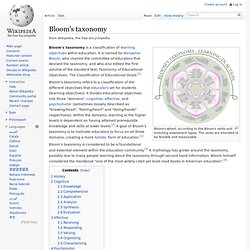
The verbs are intended to be feasible and measurable. Bloom's taxonomy is a classification of learning objectives within education. Evaporating Cloud. Overview[edit] The most commonly used of the TOC tools,[note 1] the EC was designed to address conflict or dilemma situations (trade-off situations where there is no acceptable compromise) by diagramming the logic behind the conflict and methodically examining the assumptions behind the logic. [3] The EC has a set format with five boxes, labelled A, B, C, D, D’, that are usually laid out as follows:[4] The generic structure of an Evaporating Cloud diagram.
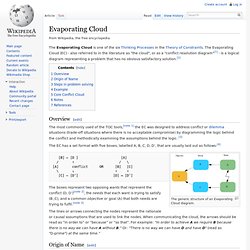
[B] ← [D ] [A] / ↑ / \ [A] conflict OR [B] [C] \ ↓ ↑ ↑ [C] ← [D’] [D] ↔ [D’] Six Thinking Hats. Six Thinking Hats is a book by Edward de Bono which describes a tool for group discussion and individual thinking involving six colored hats.
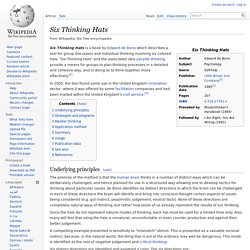
"Six Thinking Hats" and the associated idea parallel thinking provide a means for groups to plan thinking processes in a detailed and cohesive way, and in doing so to think together more effectively.[2] Underlying principles[edit] The premise of the method is that the human brain thinks in a number of distinct ways which can be deliberately challenged, and hence planned for use in a structured way allowing one to develop tactics for thinking about particular issues. de Bono identifies six distinct directions in which the brain can be challenged. In each of these directions the brain will identify and bring into conscious thought certain aspects of issues being considered (e.g. gut instinct, pessimistic judgement, neutral facts). Since the hats do not represent natural modes of thinking, each hat must be used for a limited time only.
Summary[edit] The Change Cycle. By Robert Dilts.
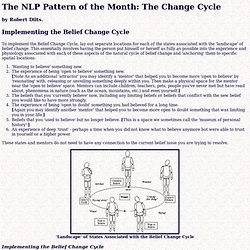
To implement the Belief Change Cycle, lay out separate locations for each of the states associated with the 'landscape' of belief change. This essentially involves having the person put himself or herself as fully as possible into the experience and physiology associated with each of these aspects of the natural cycle of belief change and 'anchoring' them to specific spatial locations. 'Wanting to believe' something new.
The experience of being 'open to believe' something new. [Note As an additional 'attractor' you may identify a 'mentor' that helped you to become more 'open to believe' by 'resonating' with, releasing or unveiling something deeply within you. These states and mentors do not need to have any connection to the current belief issue you are trying to resolve. Belief Change Cycles. By Robert Dilts People often consider the process of changing beliefs to be difficult and effortful.

And yet, the fact remains that people naturally and spontaneously change dozens if not hundreds of beliefs during their life. Perhaps the difficulty is that when we consciously attempt to change our beliefs, we do so in a way that does not respect the natural cycle of belief change. We try to change our beliefs by "repressing" them or fighting with them.
Linguistics. "IQ, Hypnosis, and Genius" IQ, Hypnosis, and Genius Let me give this genius subject a shot.

Before I get into what I want to offer in the way of processes, strategies and the like, let me offer this. The word genius is a relative term. One that has, for far too long, been associated with some of the greatest minds that have ever lived. Einstein, Tesla, Mozart, etc. This is not to say that he didn't do great things, because he did! What comes to mind now is this woman I had met once. Now there are many things that I can do, fly an airplane, build electronic systems from scratch, design and build jewelry from scratch, run a machine shop, use my communication skills to help anybody change any behavior quickly, effectively keep track of the multiple levels of communication coming at me from -- up to 100 people -- inside of a group -- while effectively tracking how my communication is being received by each and every one or them, I can explain and perform over a hundred different medical surgical procedures.
Portal:Linguistics. Neurolinguistics. This article is about the academic field of neurolinguistics.
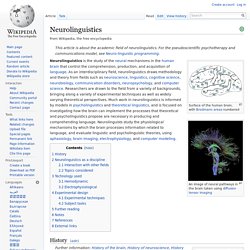
For the pseudoscientific psychotherapy and communications model, see Neuro-linguistic programming. Neurolinguistics is the study of the neural mechanisms in the human brain that control the comprehension, production, and acquisition of language. As an interdisciplinary field, neurolinguistics draws methodology and theory from fields such as neuroscience, linguistics, cognitive science, neurobiology, communication disorders, neuropsychology, and computer science. Researchers are drawn to the field from a variety of backgrounds, bringing along a variety of experimental techniques as well as widely varying theoretical perspectives.
Thought Rebound. According to studies, thoughts suppressed may resurface or manifest themselves in the future in the form of dreams.

Psychologist Daniel M. Wegner proves this in his experiment on effects of thought suppression. Thought rebound is what happens when people try to suppress a thought or memory. People’s minds’ immediate response to undesirable thoughts is to try and forget about them, pushing them back into their subconscious. But instead of doing good, there is a tendency for these thoughts to creep their way back into our minds in the form of dreams, thus sometimes making the situation worse.
Professor Daniel M. Method. Self-Deception. People lie all the time even to themselves and surprisingly, it does work!
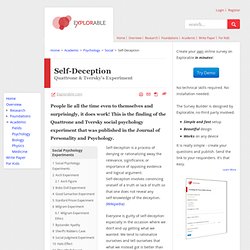
This is the finding of the Quattrone and Tversky social psychology experiment that was published in the Journal of Personality and Psychology. Self-deception is a process of denying or rationalizing away the relevance, significance, or importance of opposing evidence and logical argument. Self-deception involves convincing oneself of a truth or lack of truth so that one does not reveal any self-knowledge of the deception. (Wikipedia) Everyone is guilty of self-deception especially in the occasion where we don’t end up getting what we wanted. Quattrone and Tversky further explored this phenomenon of self-deception in their classic social psychology experiment in 1984.
Method. NLP Your Self. Transformational grammar. In linguistics, a transformational grammar or transformational-generative grammar (TGG) is a generative grammar, especially of a natural language, that has been developed in the syntactic structures of phrase structure grammars (as opposed to dependency grammars).

Transformational grammar is the tradition of specific transformational grammars. Much current research in transformational grammar is inspired by Chomsky's Minimalist Program.[1] Deep structure and surface structure[edit] Psycholinguistics. Psycholinguistics or psychology of language is the study of the psychological and neurobiological factors that enable humans to acquire, use, comprehend and produce language. [1] Initial forays into psycholinguistics were largely philosophical ventures, due mainly to a lack of cohesive data on how the human brain functioned. Modern research makes use of biology, neuroscience, cognitive science, linguistics, and information theory to study how the brain processes language. Glossary of linguistic terms. Glossary (Linguistics): P. NLP FAQ and Resources. The home of the Alt.Psychology.NLP Newsgroup!
I've added an NLP Self-Help Blog at to enhance the FAQ, and provide more help to those exploring NLP for self development. Table of Contents Answers to common questions: The Alt.Psychology.NLP FAQ. Encyclopedia of NLP. The Big Book Of NLP Techniques. Turtles All the Way Down: Prerequisites to Personal Genius. NLP World. IANLP. Human Heart, Electromagnetic Self Communication. 29th February 2012 By mindfulmuscleblog.com Heart Fields Many believe that conscious awareness originates in the brain alone. Recent scientific research suggests that consciousness actually emerges from the brain and body acting together.
A growing body of evidence suggests that the heart plays a particularly significant role in this process. Far more than a simple pump, as was once believed, the heart is now recognized by scientists as a highly complex system with its own functional “brain.